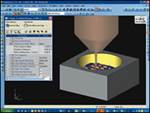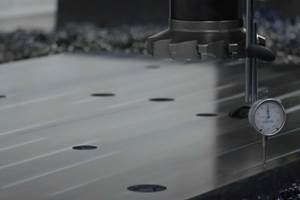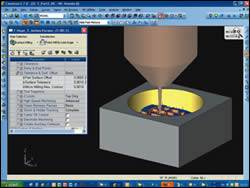MTD Micro Molding
This shop specializes in building molds for tiny parts with such complexities as 0.1-mm walls, 0.025-mm corner radii and holes as small as 0.051 mm in diameter.
What is a micro-mold?
Carl Lemieux, Tooling Supervisor for MTD Micro Molding: We use the term “micro-mold” for molds that make small, micro-sized molded parts. Many of these molds have multiple small features viewable only under a microscope and measurable under magnification with optical equipment. Micro-molds require an extremely high level of precision and skill to build. Highly capable equipment and tools are required to create the highly complex geometries in steel that the micro-medical-component designs demand.
What type of end products do your molds produce?
MTD: Our molds are capable of producing parts that include features such as 0.1-mm walls, 0.025-mm corner radii and holes as small as 0.051 mm in diameter. One of the typical parts that we mold is approximately 2 by 4 mm. We have also molded parts so small that one plastic pellet could produce more than 500 parts. Our molded products are generally micro-sized medical device components. These medical devices support a variety of medical end markets, including fixation, drug delivery, cardiac, biomed pharma, neurosurgical, bronchoscopy, oncology, urology, orthopedic, endoscopy, ears-nose-mouth and gastrointestinal. A large portion of the parts we produce are bio-absorbable, which is popular in micro-medical applications as the materials can dissolve/absorb into the body, eliminating the need for additional surgeries.
How are design, build, inspection, maintenance and repair strategies and processes different for micro-molds?
MTD: Design: Smaller runners, smaller gates, and because of the tiny details in the designs, most of the ejector pins are very small (sometimes as small as 0.010 inch). There also are much tighter fits and tolerances, and venting is minimal compared to macro-molds.
Build: Building these tools is challenging. Precise planning is required, as well as close tracking through milling, grinding, wire and sinker EDM. In all of these areas, it is crucial to be as accurate as possible to avoid cumulative error. With extremely small details, any slight inaccuracy can result in a major issue. Also, micro-molds for bioabsorbable products are unique, as they are designed and constructed differently than molds for non-bio-absorbable parts.
Inspection: As we go through the mold-building process, each tooling department is required to inspect and verify that the end product produced is dimensionally correct before handing it off to the next department.
Maintenance: One of the main differences with micro-molds is their physical size, which makes them much easier to handle during assembly and disassembly. The mold core, cavity, inserts and side actions are generally tiny and extremely delicate, which requires very deliberate methods of disassembly and assembly for cleaning and replacing any worn parts. Cleaning some parts of the mold may require magnification and special tools.
Repair: Generally, damaged micro-mold components must be replaced, either with a rebuilt piece or spare components. Micro-welding a damaged component is rarely an option in micro-tooling, but can be used in certain cases if it does not compromise the integrity of the mold steel.
What is the biggest challenge working with micro-molds?
MTD: It is difficult to pinpoint the biggest challenge with micro-molds, because each mold has its own unique set of challenges. Smaller medical parts usually require more defined and critical detail. We are often challenged to come up with innovative ways to create those features in a mold that will then produce injection-molded parts that meet the drawing requirements. While much of the challenge is in the design, there are challenges at every level. For example, manufacturing electrodes for the sinker EDM process and grinding tiny highly detailed core pins needed to produce features such as holes as small as 0.005 inch in diameter. Custom fixtures are generally required to hold the tiny inserts in order to machine them using sinker or wire EDM. Many times, the part design requires a core or cavity block with multiple tiny inserts that fit together like an intricate puzzle.
What unique tools are in your toolbox?
MTD: While we do have most of the typical machines you would find in most shops, such as a CNC lathe, CNC graphite milling machines, wire EDMs and surface grinders, we have one machine that sets us apart from all other mold shops: our Sarix CNC EDM milling machine. It uses a 0.4-mm carbide rod that can be dressed down to 5 microns and has a positioning accuracy of ±1 micron. It works very similar to a CNC milling machine, but uses a cylindrical spinning carbide electrode instead of an end mill. Not all of the micro-molds we build require this technology, but it is available for molds that require extreme levels of detail, like mirror-like finishes, razor-sharp corners or extremely small through-holes. Our most unique tool, however, is our people. MTD’s toolmakers have the unique skill sets and know-how to work at the level of accuracy our micro-molds demand.
What special training do MTD toolmakers receive?
MTD: We have a very talented group in our toolroom. Most employees have 20+ years in the machine tool trade. When our toolmakers start, they tend to go through a severe adjustment in reaction to how closely tolerances need to be held in ultra-precision micro-molding. All toolmakers are trained in the use of the toolroom software and machine operations in the shop. We are constantly building on our experience, always learning from each project and evaluating how it can be done better the next time.
Do you use any additive technologies or 3D printing?
MTD: We have a 3D printer that is used primarily for printing parts used in molding cell automation and measurement fixtures. It is extremely helpful to have the ability to 3D-print a part to prove out a concept or a design, and then create it out of the desired material once we verify the concept will work.
What are some recent trends in micro-molds and molding?
MTD: The micro-molding industry is allowing medical devices to get smaller with tighter tolerances and to be made of even more exotic materials. We are seeing an evolution in which medical devices are being designed to take advantage of new and advancing technologies. For example, 3D printing might have an influence as it becomes more refined and able to be used in more applications; “smarter” camera systems and robotics; bio-absorbable materials in injection-molded medical devices; combining micro-products with a macro-piece as an assembly; injection molding a second material onto a micro-part; custom compounded resins and special recipe materials to meet exact needs of applications, including pharmaceutical filled materials and larger device manufacturers outsourcing critical manufacturing technologies at the component and assembly level.
Related Content
The Trifecta of Competitive Toolmaking
Process, technology and people form the foundations of the business philosophy in place at Eifel Mold & Engineering.
Read MoreControl Helps Push the Limits of Five-Axis Micro Mold Machining Accuracy
Toolmaker quickly meets the demands of critical medical device manufacturers with a new five-axis machine tool equipped with the right control technology.
Read MoreHow to Produce More Accurate Molds and Reduce Rework
Patented micro-milling process for manufacturing steel plate flat and parallel helps mold builders shorten mold build times and increase accuracy.
Read MoreMoldmakers Deserve a Total Production Solution
Stability, spindle speed and software are essential consideration for your moldmaking machine tool.
Read MoreRead Next
Opportunities for Mold Shops with Micro Molds and Micro Milling
Learning about the trends and challenges with micro molds and micro milling will help shops maintain their competitive edge.
Read MoreHow to Use Continuing Education to Remain Competitive in Moldmaking
Continued training helps moldmakers make tooling decisions and properly use the latest cutting tool to efficiently machine high-quality molds.
Read MoreAre You a Moldmaker Considering 3D Printing? Consider the 3D Printing Workshop at NPE2024
Presentations will cover 3D printing for mold tooling, material innovation, product development, bridge production and full-scale, high-volume additive manufacturing.
Read More













.jpg;maxWidth=300;quality=90)















